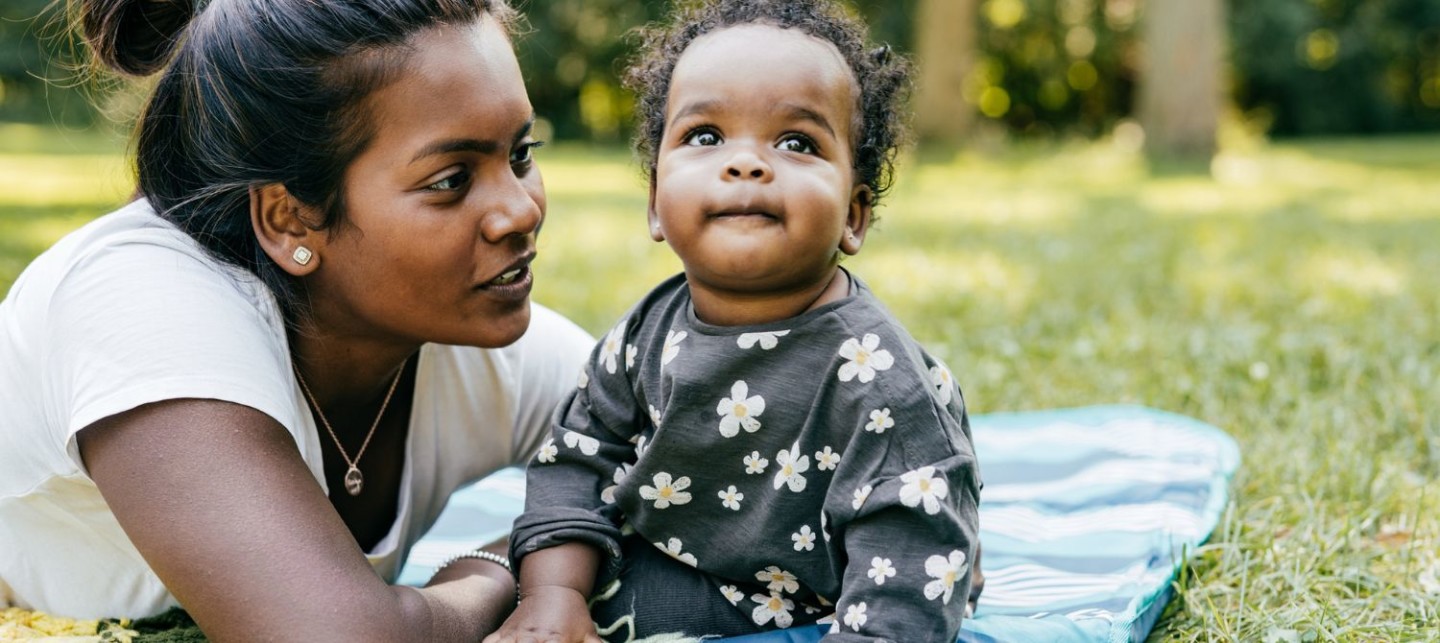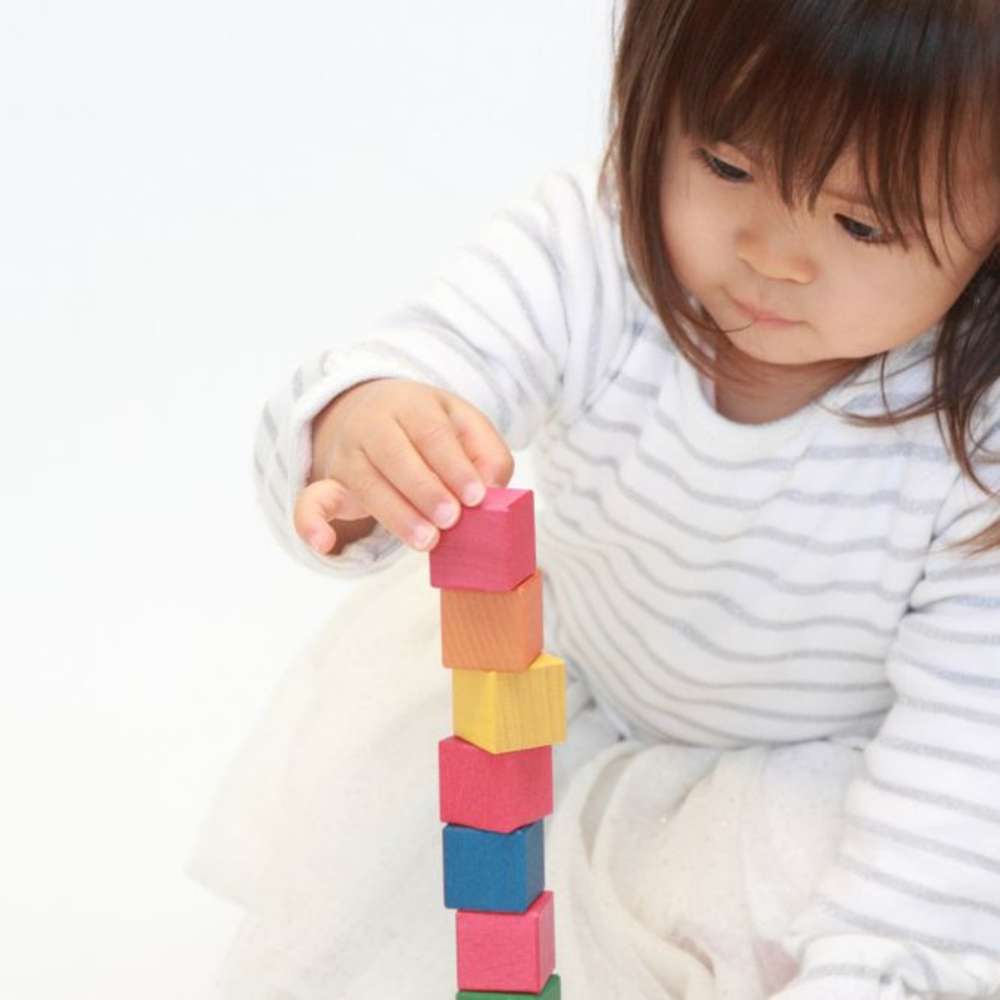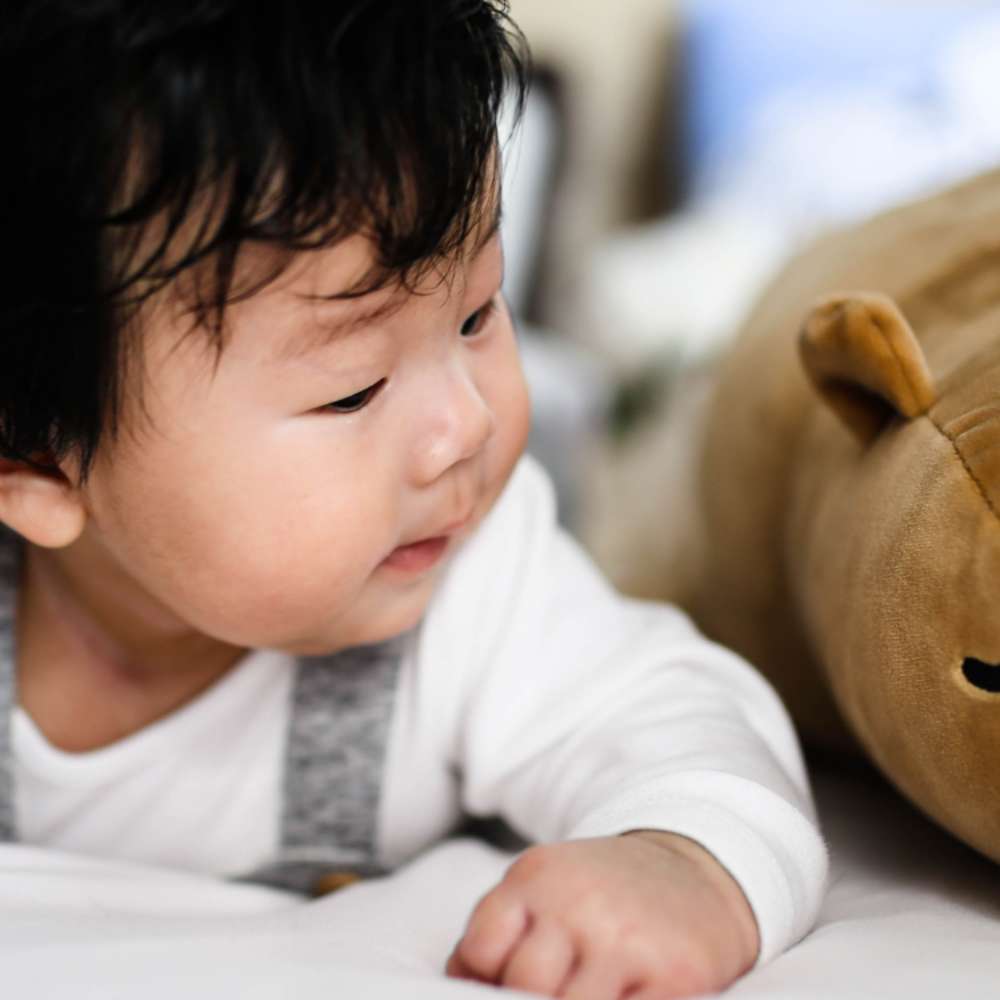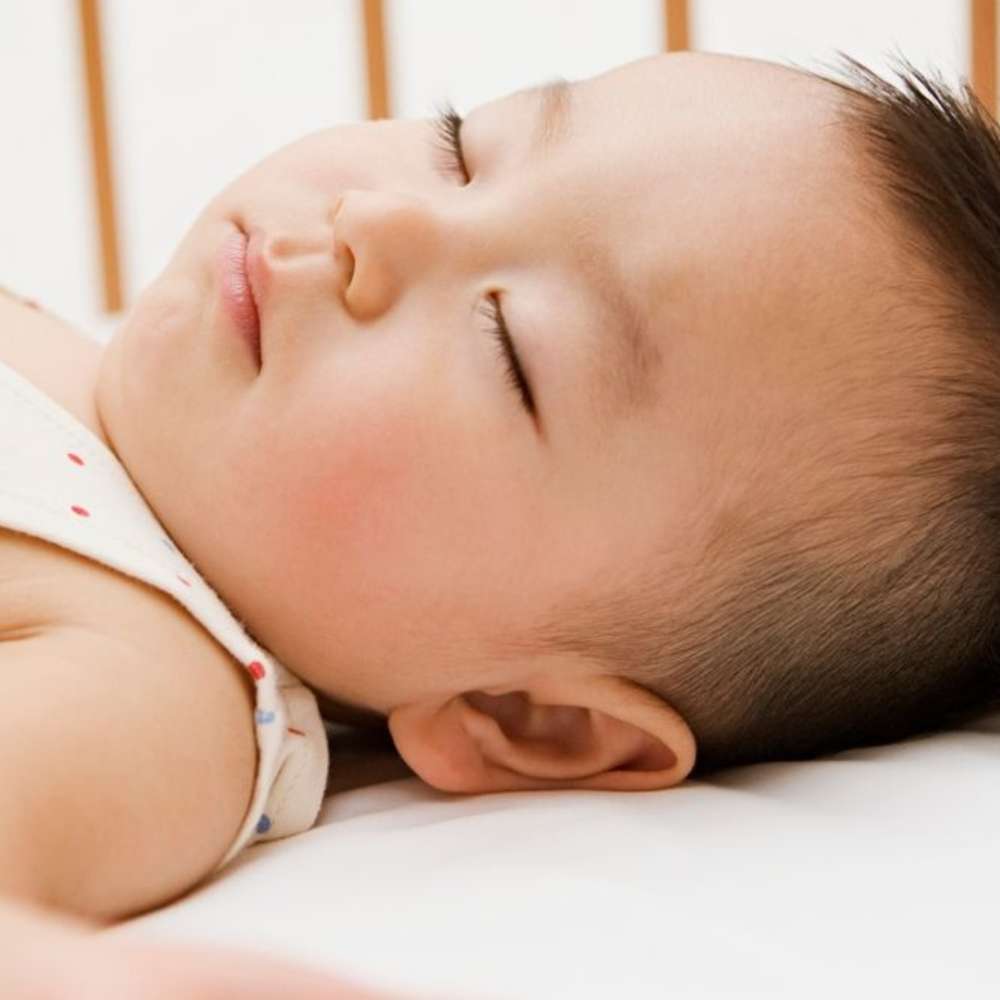7 month old baby milestones: Development, growth, speech, language, and more

At 7 months, babies are working on so many exciting skills like babbling, eating solids, and using their hands to explore. They’re also working on sitting up at this age, which allows them to see the world from a different point of view.
In this article, we’ll examine the physical and social milestones you can expect from 28 - 32 week old babies, give you a handy 7 month development checklist, and provide tips to help your little one learn and grow.
Editor's Note:
Note that when we discuss babies and development at Huckleberry, we use their adjusted age (vs. actual age). Keep in mind there’s a wide spectrum when it comes to 7 month developmental milestones. If you have concerns about your baby’s health or any potential development delays, talk to their pediatrician.
IN THIS ARTICLE:
7 month old baby milestones at a glance
7 month development milestones
7 month development milestones checklist
5 development tips for 7 months
Takeaway: Development milestones for 7 month olds
7 month old development milestones FAQ
7 month old baby milestones at a glance
Development:
By 7 months, your little one is likely already rolling both ways pretty well and is now working on sitting up. It might take a while for them to truly sit on their own, so expect to see a progression from wobbly sitting with support to independent sitting with more control. It’s hard work for babies!
On the speech front, 28 - 32 week olds are typically babbling and responding to the sounds they hear. It’s possible that they even know their own name! At this age, babies are usually able to track moving objects a lot better and spot things across the room since their distance vision has likely matured.
Sleep:
While the amount of sleep required varies from baby to baby, we recommend little ones at 7 months get around 11 - 12 hours of sleep at night and 2.5 - 3 hours of naps during the day. This daytime sleep is typically split over three naps.
However, it's common for babies to experience a slight reduction in nighttime sleep as they approach the age when they're ready to drop their third nap, usually in a month or two. This change occurs as babies require more awake time between sleep sessions, but aren't fully prepared to eliminate a nap, leading to a later bedtime and a somewhat shorter duration of sleep at night.
At 7 months, ideally, your baby’s first two naps of the day are at least an hour long. If your little one is taking 3 naps, the last nap of the day will likely be shorter, around 30 - 45 minutes. Babies typically stay awake between 2.25 - 3.5 hours at a time at this age.
7 month olds can usually sleep for longer stretches overnight. However, it’s common for babies to still have 1 - 2 night feedings at this age. Unless directed by your pediatrician, there’s no need to wake your child up during the night to feed them at this age.
There’s a wide range of what's normal and healthy for baby sleep and these suggestions offer a basic guideline. It’s also helpful to observe your child's mood and energy levels when evaluating their individual sleep requirements.
Feeding:
At 7 months, breast milk or formula will continue to be the main source of nutrition for your little one. It’s expected that babies have around 4 - 6 feeds in a 24-hour period at 6 months and at 7 months this is likely still the case.
Your little one is also probably experimenting with the world of solids at this age. The American Academy of Pediatrics [1] recommends introducing solid food to most babies starting at 6 months. At 7 months, it’s normal for your little one to be exploring solid food (rather than consuming a certain number of calories per day) and getting pretty messy in the process! Continue offering a variety of foods to your little one but don’t expect them to love every bite right away — it can take repeated exposures [2] for babies to try and like new foods.
Growth:
Your baby at 7 months will probably gain around 0.5 - 1 pound [3] over the course of a month and grow about .5 inches in height. Note that these are guidelines and it’s normal for your little one to grow more or less than this between 28 - 32 weeks.
Your child’s doctor will continue to plot their height and weight gain during visits to ensure they’re growing steadily and to catch any health trends that need attention. If you have concerns about your baby’s growth and development, consult their pediatrician.
7 month development milestones
Physical development
Gross motor skills
Rolling over: Let’s roll! By 7 months, babies can usually roll well both ways (tummy to back and back to tummy) [4]. They can even do this in their sleep.
Sitting up: Around 28 weeks, babies can typically sit up on their own [5]. This happens first with support from their hands and then transitions to sitting without support. They might not be able to get into a sitting position on their own until closer to 9 months.
Crawling: Some babies start crawling as early as 7 months. The typical timeframe for crawling is 7 - 10 months [6], so don’t fret if your child isn’t there quite yet. Instead, your little one might begin to scoot or rock back and forth on their hands and knees as they gear up to crawl. Also, note that motor skill development looks different for all babies — some children skip the crawling stage! [6]
Fine motor skills
Hand-eye coordination: Big things are happening in the world of hand-eye coordination for little ones at this age. Most babies can move objects from one hand to another [4] or directly to their mouths at this point. We recommend making sure small toys and other choking hazards are removed from your baby’s play space now that they’re able to put things in their mouth easily. Babies at 7 months are quick!
Hand movements: 7 month fine motor milestones typically include using a raking motion to pull objects closer to them. This skill comes before they’re able to use refined movements to grab items with their thumb and forefinger (called “pincer grasp”) around 8 - 9 months. These hand movements make things like feeding themselves much easier.
Visual development
Vision improvements: Babies can usually see in full color [5] at 7 months. This is also around that distance vision matures — don’t be surprised if your baby can spot you from across the room now! Little ones are able to track moving objects a lot better at this stage.
Speech development
Babbling: Your baby is likely making all sorts of sounds at 28 weeks. Around this time, their babbling likely includes chains of sounds like “dah-dah-dah.” They can usually even make two-syllable sounds like “ma-ma.” [4] At 7 months, babies can’t quite connect that they’re saying “mama” even if they’re making the sounds. It’s just babble to them! Children will likely be able to say “mama” and “dada” with intent by 12 months [7].
Responding to sounds: One of the exciting 7 month old speech milestones is your baby might start to respond to their own name! [5] They typically respond by making sounds or looking in the direction of your voice. In general, babies at this age tend to respond to all sorts of noises by making sounds of their own. It’s their version of a conversation.
Pointing: Babies at this age might be able to point, although 7 months is the earliest end of the spectrum. Most children learn to point between 7 - 15 months [8]. You can model pointing at objects and then label them to help set the foundation for the skill and give your little one a boost in the language department too.
Social development
Emotional development
Stranger anxiety: If your baby used to let anyone hold them and suddenly they do not want to go to anyone but you, stranger anxiety [5] is usually to blame. Typical 7 month old emotional development means children are starting to understand there’s a difference between you (their primary caregiver) and other adults and might fuss if you leave or someone else holds them. However, little ones at this stage are also usually easily distracted and will likely stop crying as soon as you’re out of sight.
Emotions: Babies are learning the basics of emotions around 7 months. They are usually able to pick up on them [5] through tone of voice and they even start to express their own joy and displeasure by using their voice.
7 month development milestones checklist
Keep in mind there’s a wide spectrum of normal when it comes to children’s growth and development between 7 - 8 months. Not all children at this age will reach these 7 month old milestones at the same time — some may hit them earlier, some later. If you do have concerns about your little one’s growth or notice any potential development delays, have a conversation with their healthcare provider.
Rolling well both ways
Sitting up (assisted then unassisted)
Move objects from one hand to another
Place items directly in their mouth
Rake objects closer to them
See in full color
Track moving objects well
Babble a chain of sounds
Respond to own name and various noises
Pick up emotions through tone of voice
Express joy or displeasure through sounds
5 development tips for 7 months
Tip #1: Explore textures
Things that seem mundane to you are very exciting for your 7 month old! Let your baby explore different textures and surfaces when you’re at home and also outside — like grass, leaves, dirt, etc. Research shows [9] the amount infants explore with their hands is related to their gesture and sound use at 12 months. Keep in mind little ones explore with their hands and mouths too (and can roll fast!) so be sure to keep the area clear of hazardous items.
Tip #2: Mirror mirror
At this age, your baby is too young [10] to recognize themself in a mirror, but 7 month olds can still enjoy playing in front of one. It’s a good opportunity to reinforce learning their name, by calling it out and pointing to their reflection. Babies at this age like to smile at themselves in the mirror too.
Tip #3: Babble on
Encourage your 7 month old’s speech development by babbling back [3] to them. Repeat the sounds they make and expand on them too. For example, if your baby says “dah,” you could say “dah-dah-dah” back to them to keep the “conversation” going.
Tip #4: Give reading a boost
You’ve probably already been reading with your little one — keep up the good work! Reading is an important learning and bonding activity for your 7 month old. At this age, you can also try things like pointing to and labeling pictures [4] in a book and using different voices or sound effects for various characters. Make it fun!
Tip #5: Peek-a-boo can be funny now
Peek-a-boo is one of the oldest tricks in the book when it comes to activities for babies but did you know it serves different purposes as your little one progresses [11]? For younger infants, it can help babies visually track the “peeks” from different places. Between 6 - 9 months, little ones get curious and peek-a-boo might even inspire a laugh!
Takeaway: Development milestones for 7 month olds
Milestones at 7 months mean your baby is getting to be so much more interactive! They’re likely babbling and responding to sounds and might even react to hearing their own name. Plus they’re eating solids and working on the fine motor skills needed to feed themselves.
Around 28 weeks, babies are also starting to see the world from different angles. They’re rolling both ways, sitting up, and sometimes working on the motor skills that come before crawling, like rocking back and forth on their hands and knees.
Fine motor skills are developing at this point too. Babies around 7 months are able to pass objects from one hand to the other. They can also move items from their hands to their mouth. Looking ahead, the use of the thumb and pointer finger (called “pincer grasp”) typically develops around 8 - 9 months, which makes it easier for little ones to feed themselves.
This month of development is an exciting one. Babies learn and grow every day at this age! Remember that not all babies will reach these milestones at the same time, though. It’s normal for some children to reach milestones sooner than others. Consult your child’s healthcare provider if you notice any developmental delays or 7 month old milestone red flags.
If you're curious about what lies ahead in the next month, glimpse into the future to see what you might experience once your baby is 8 months old.
7 month old development milestones FAQ
Q: What should a 7 month old be able to do?
A:
At 7 months, little ones are typically rolling both ways and working on their sitting skills. They’re also exploring the world with their hands and are usually able to move objects from hand to hand and bring an item to their mouth. Most 7 month olds are babbling and responding to sounds and might even recognize their own name.
Q: What are 3 major physical milestones by 7 months of age?
A:
An exciting expected 7 month gross motor milestone is sitting up. This first happens with a baby supporting themselves with their hands (or using a wall or pillows etc.) then develops into independent sitting. At around 7 months fine motor skills include transferring items from hand to hand and using a raking motion to bring objects closer to them.
Q: What does a 7 month old understand?
A:
Little ones might be able to respond to their own name at 7 months! They pay attention to conversations and are starting to grasp emotions — by looking at your facial expressions and also using their voice to express happiness and displeasure. They are also grasping that you are their primary caregiver and might be upset if you leave the room or someone else holds them.
Q: How to help a 7 month old reach milestones?
A:
Talking and reading to your baby are important tools for 7 month old language development. Encourage your child to babble and make noise by responding to their sounds as much as possible. Playing social games like pat-a-cake and peek-a-boo are also good development tools and you might even be rewarded with a big smile or laugh from your little one. It’s also important for your 7 month old to continue tummy time at this age to build the neck, back, and shoulder muscles needed for crawling.
Q: What milestones should a 7 month old have for a pediatric visit?
A:
Typically children are seen for scheduled well-baby visits at 6 then 9 months. If your child visits the pediatrician at 7 months, they will likely ask if you have noticed any developmental red flags when it comes to social, emotional, and physical milestones. You can expect the doctor to ask if your child is rolling over both ways, sitting up, responding to their name, able to track you from across the room, and will chart their height and weight to make sure they are growing appropriately.
Note: The content on this site is for informational purposes only and should not replace medical advice from your doctor, pediatrician, or medical professional. If you have questions or concerns, you should contact a medical professional.
11 Sources
American Academy of Pediatrics (2022). Starting Solid Foods. https://www.healthychildren.org/English/ages-stages/baby/feeding-nutrition/Pages/Starting-Solid-Foods.aspx
Scaglioni, S., Cosmi, V. D., Ciappolino, V., Parazzini, F., Brambilla, P., & Agostoni, C. (2018). Factors Influencing Children’s Eating Behaviours. Nutrients. https://www.ncbi.nlm.nih.gov/pmc/articles/PMC6024598/#B28-nutrients-10-00706
Children’s Hospital of Orange County (2023). 7-9 Month Old Baby Development & Milestones. https://www.choc.org/primary-care/ages-stages/7-to-9-months/
Mayo Clinic (2022). Infant development: Milestones from 7 to 9 months. https://www.mayoclinic.org/healthy-lifestyle/infant-and-toddler-health/in-depth/infant-development/art-20047086
American Academy of Pediatrics (2009). Developmental Milestones: 7 Months. https://www.healthychildren.org/English/ages-stages/baby/Pages/Developmental-Milestones-7-Months.aspx
American Academy of Pediatrics (2021). Movement: Babies 8 to 12 Months. https://www.healthychildren.org/English/ages-stages/baby/Pages/Movement-8-to-12-Months.aspx
Munshi, D. (2021). My baby is turning a year old this month. Should she be talking by now? https://www.healthychildren.org/English/tips-tools/ask-the-pediatrician/Pages/one-year-old--Should-she-be-talking-by-now.aspx
The Hanen Centre (2016). What’s the Point of Pointing? https://www.hanen.org/Helpful-Info/Articles/What%E2%80%99s-the-Point-of-Pointing-.aspx
Zuccarini, M., et al. (2018). Does early object exploration support gesture and language development in extremely preterm infants and full-term infants? Journal of communication disorders. https://pubmed.ncbi.nlm.nih.gov/30300842/
First Things First (2024). Reflecting on babies and mirror play. https://www.firstthingsfirst.org/first-things/reflecting-on-babies-and-mirror-play/
Pathways (2024). Parents’ Guide to Stages of Peek-a-Boo. https://pathways.org/watch/parents-guide-to-stages-of-peek-a-boo/



